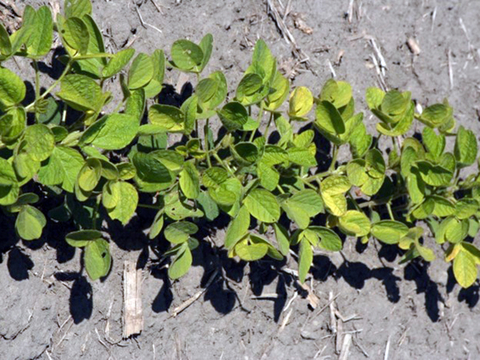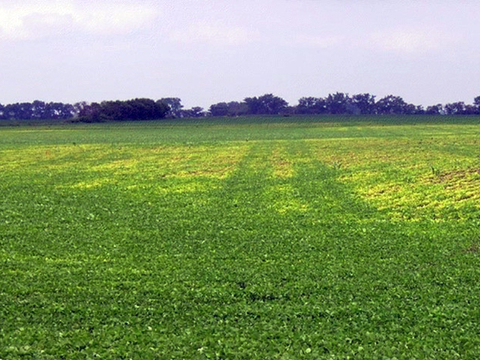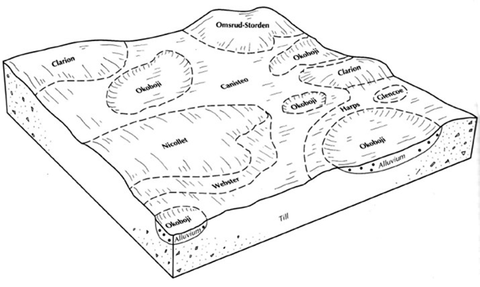Iron deficiency chlorosis in soybean, otherwise known as IDC or iron chlorosis, is a problem for soybean production in South Central, Southwest, West Central and Northwest Minnesota. The primary symptom is interveinal chlorosis (yellowing) of the leaves with the leaf veins remaining dark green.
Iron (Fe) is required by several enzymes involved in the formation of chlorophyll and lack of active iron in leaves leads to chlorosis. Soil normally contains large amounts of iron, but it is not in the soluble form needed by the plant. The most soluble form in oxidized (aerated) soils is Fe(OH)3, where iron is in the Fe(III) form. This iron becomes less soluble at higher soil pH, especially when the soil has large amounts of calcium carbonate.
Plants prefer to take up the reduced form of iron (Fe II) and have adapted mechanisms to help extract iron from the soil.
- Type I plants, such as soybean, azaleas and blueberries excrete acids and chemical reductants from their roots. The acids make the Fe(OH)3 more soluble and the reductants change insoluble Fe(III) to more soluble Fe(II).
- Type II plants such as corn and grasses excrete iron chelators that bind Fe(III) allowing the iron to be absorbed through the root.
Plants vary in their ability to extract Fe from the soil. Azaleas and blueberries only survive in acidic soils where Fe(OH)3 is more soluble. Because of this, azaleas and blueberries are chlorotic in soils with a pH greater than 5.5 while soybeans can adequately grow when pH is less than 7.5.
Aggravating conditions for IDC
Type I plants and high lime (calcium carbonate) IDC
High lime IDC is quite common for soybean, peanut, grapes, citrus and peaches. The use of a soil test for iron will generally not indicate these problems.
High lime IDC is more severe in soils with finely divided lime (calcium carbonate). The fine calcium carbonate particles contact the soybean root, slowly neutralize the excreted acid that is meant to solubilize iron in the soil and inhibit the plant from taking up iron that is in the soil.
Wet soil
When soil is wet, there is limited air exchange with the atmosphere causing a buildup of carbon dioxide in the soil that is produced by roots and soil microbes through respiration. The amount of bicarbonate in the soil is proportional to the amount of carbon dioxide, and as carbon dioxide increases so does bicarbonate. This increase will rapidly neutralize the acidity around the soybean root.
Research in the greenhouse has shown that the severity of IDC increases for soybean growing on waterlogged soils, and especially when soils are cold. The amount of bicarbonate in the soil has been correlated with IDC in soybean in the field, so the more bicarbonate in the soil the more IDC will occur.
In wet soil conditions, it may be useful to consider cultivation to speed the release of carbon dioxide from the soil.
Addition of fresh organic matter
Decaying organic matter, whether it is from crop residues or manures, adds to the amount of carbon dioxide in the soil as microbes release carbon dioxide. If soil is wet, diffusion of the carbon dioxide out of the soil will be limited, increasing the risk for buildup of bicarbonate in the soil and therefore increasing the severity of IDC.
Nitrate in the soil
Soil nitrate in the field can increase chlorosis. Field and greenhouse studies have shown the addition of nitrate increases the severity of chlorosis in soybean.
Nitrate can affect IDC in two ways.
- First, when a plant root takes up nitrate it must exchange with a bicarbonate ion.
- Second, nitrate taken up into the plant must be converted to ammonium within the leaves, which increases pH in leaf sap and decreases the rate of reduction of Fe III to Fe II, which is necessary for leaf cells to have usable Fe.
When taking plant samples from chlorosis fields, iron in leaflets can be greater in the chlorosis-affected plants than non-chlorotic plants because of an accumulation of iron in the leaves without the ability to reduce the iron III into an available form.
Differences in soil nitrate may explain why we often see less chlorosis in the wheel tracks of the secondary tillage in a soybean field.
- The soil under the tractor wheels is more compacted, causing the compacted area to be more anaerobic (low air), but not low enough to reduce much Fe III to Fe II.
- The slightly anaerobic soil conditions can cause denitrification of nitrate to N2, reducing the amount of nitrate in the soil and thus reducing the amount of IDC.
The effect of soil nitrate-N on IDC and soybean grain yield
| N rate (lb/acre) | Oat companion crop | C06 grain yield (bu/acre) | YM06 grain yield (bu/acre) | K07 grain yield (bu/acre) | YM07 grain yield (bu/acre) |
|---|---|---|---|---|---|
| 0 | No | 42.1 | 52 | 3.6 | 51.7 |
| 100 | No | 28.5 | 32.2 | 0.3 | 46.5 |
| 200 | No | 25.3 | 19.1 | 0.1 | 40.2 |
| 0 | Yes | 42.5 | 52.4 | 52.4 | 50.7 |
| 100 | Yes | 20.5 | 42.6 | 42.6 | 43.4 |
| 200 | Yes | 18.9 | 25.9 | 25.9 | 33.7 |
Plant stress
Any production practice that can cause stress to the plant can also cause problems with iron uptake by the plant. Examples include herbicide injury, (especially from soil-applied products), plant disease pressure and nematodes.
Soybean cyst nematode (SCN) populations can be very high in field areas where IDC occurs. While both maladies can cause stunting and yellowing of soybean, research in Minnesota has not shown an interaction between SCN and IDC. Management strategies for both SCN and IDC should be considered when these exist within the same field.
Where we find IDC in Minnesota fields
Soybean IDC generally occurs in shallow depressions. IDC is generally worse on the rims of the potholes where higher concentrations of calcium carbonate have been deposited, caused by historic soil conditions when the soils were wet prairies before tile drainage and farming.
The intensity and extent of IDC depends on the soybean variety and factors that affect soil nitrate and bicarbonate contents.
How to manage IDC
Soybean variety selection is important. If you have a field with a history of IDC, choose the most tolerant variety possible.
Recent field research indicates that tolerant varieties have greater yield where IDC is a problem, but even higher yields can be achieved when combined with treatments used to decrease the severity of IDC.
A tolerant variety should be the first line of defense against IDC.
Effect of oat and 3 pounds of an in-furrow ortho-ortho chelate (1F-Fe) on soybean yield
| IDC soil pressure | Soybean variety | Chk grain yield (bu/acre) | IF Fe grain yield (bu/acre) | Oats grain yield (bu/acre) | Oat + Fe grain yield (bu/acre) |
|---|---|---|---|---|---|
| Low | V1: IDC susceptible | 47.2 | 50.9 | 42.8 | 48.8 |
| Low | V2: IDC tolerant | 46 | 49.5 | 42.7 | 46.7 |
| Moderate | V1: IDC susceptible | 30.6 | 38.7 | 26.9 | 41.7 |
| Moderate | V2: IDC tolerant | 42.5 | 46 | 32.1 | 43.6 |
| High | V1: IDC susceptible | 6.6 | 15.3 | 26.6 | 28.5 |
| High | V2: IDC tolerant | 16.6 | 26.5 | 23.2 | 31.8 |
Use a companion crop, particularly where soil nitrate may be high. The companion crop in these situations can take up the excess soil nitrate while drying moist soil to reduce bicarbonate levels.
The use of a companion crop such as oat, seeded at a 1.5 bushel per acre rate at or before soybean planting, has been shown to increase soybean grain yield in IDC affected areas of the field. This practice does require extra management, and oat must be terminated by the time it is 10-12 inches in height.
Delays in termination exacerbate drought stress and early termination does not allow time for sufficient nitrate uptake or soil moisture reduction by the companion crop.
The effect on soybean grain of oat companion crop killing time
| Stage of oat growth | Grain yield: K07 | Grain yield: C09 | Grain yield: R09 |
|---|---|---|---|
| No oats | 17 bushels per acre | 51 bushels per acre | 36 bushels per acre |
| 6 inches tall | 14 bushels per acre | 52 bushels per acre | 40 bushels per acre |
| 12 inches tall | 35 bushels per acre | 53 bushels per acre | 41 bushels per acre |
| Heading | 24 bushels per acre | 49 bushels per acre | 34 bushels per acre |
The effect of nitrate-N and companion crops on IDC severity and soybean growth
Click on any image to enlarge.
Reduce plant stress as much as possible.
- The use of glyphosate herbicide for weed control is less stressful to the plant compared to some conventional herbicides. If possible, avoid herbicides that injure soybean at the most critical early stages of growth.
- Reduce root damage from cultural practices such as excessive and deep cultivation.
- Beware of soil conditions that cause compaction during the tillage and planting operations. Compaction of surface soil at planting can stress a plant for the entire growing season.
- Be sure to treat plant diseases and other pests according to accepted thresholds.
- It has been suggested that tile drainage can help reduce the effect of IDC. While it is theoretically possible, tile drainage only removes gravitational (free) water from the soil and portions of the soil may remain saturated after drainage. Many fields in Western MN affected by IDC still exhibit IDC symptoms, so while tile drainage may reduce overall plant stress it is not likely to eliminate the risk of IDC in the field.
Use an in-furrow placement of an iron chelate product composed primarily of iron in the ortho-ortho form. Research has shown great success with the application of ortho-ortho chelated iron with the seed.
Use of other products and application methods has not produced consistent results. Most research data suggest that a rate of 1-3 pounds of dry product per acre of the ortho-ortho chelate will increase yield. The research data also suggests that areas moderately or highly affected by IDC should be targeted first to maximize profit potential across the field.
The effect of seed placed ortho-ortho-iron chelate on soybean grain yield
| Seed placed | Grain yield: K07 | Grain yield: YM07 | Grain yield: C08 | Grain yield: R08 | Grain yield: C09 | Grain yield: R09 |
|---|---|---|---|---|---|---|
| No | 21.8 bushels per acre | 53.6 bushels per acre | 30.0 bushels per acre | 30.2 bushels per acre | 48.0 bushels per acre | 43.0 bushels per acre |
| Yes | 41.5 bushels per acre | 55.3 bushels per acre | 44.2 bushels per acre | 29.5 bushels per acre | 49.0 bushels per acre | 42.0 bushels per acre |
Increasing soybean seeding rate has been reported to reduce the severity of IDC. But the effect of increasing seeding rate has been found to be relatively small and inconsistent among various environments.
Recent data shows that increasing seeding rate can increase net return per acre for a highly tolerant variety grown in an area with severe IDC.
While increased seeding rates may not be economically viable in all situations, farmers should be especially careful to avoid deficient stands where IDC may be a concern.
Net return from increased seeding rate was not as high as implementing other factors such as adding an ortho-ortho EDDHA iron chelate (Soygreen).
Tailor practices to your farm
Research involving the combination of tolerant variety, companion crop, seed placed ortho-ortho chelate, and soybean seeding rate has demonstrated that each can be used to reduce the impact of IDC. But IDC is a process that is impacted by both soil and environmental factors.
While all factors together may potentially benefit soybean by reducing IDC severity, you may not need to do all of these things to reduce IDC severity.
From both a yield and economic perspective, the management practices that were most beneficial for producers were variety selection, followed by a seed placed ortho-ortho chelate, increased seeding rate, and lastly the companion crop.
Farmers should tailor these practices to their farms or parts of farms based on risk of loss from IDC as well as their own logistical, mechanical or management limitations.
Reviewed in 2023




